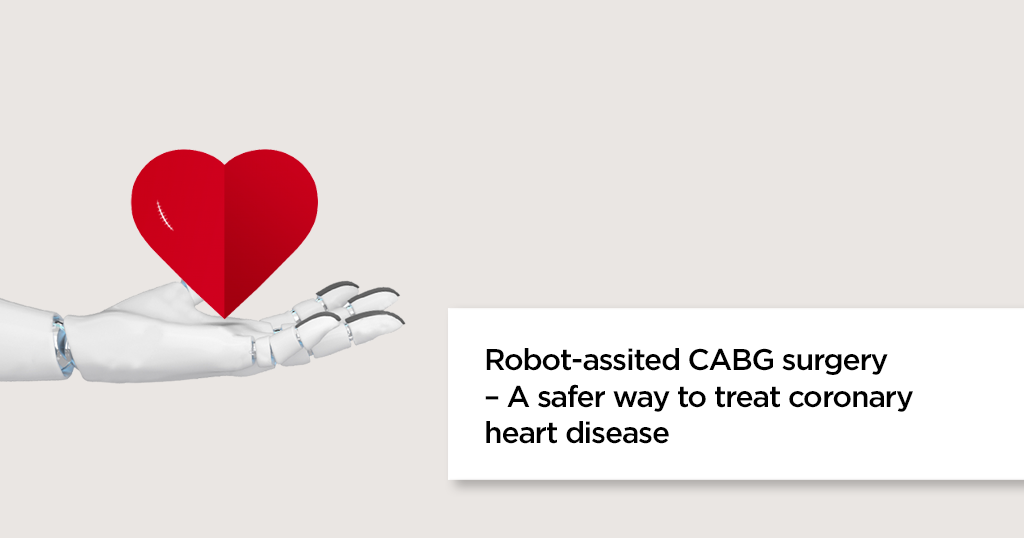Overview
Traditionally, CABG (Coronary Artery Bypass Graft) surgery is performed by cutting open (separation of) the chest bone, which requires a large incision and longer recovery time. While traditional CABG procedures are also widely performed, the newer and more advanced minimally invasive alternatives, such as robot-assisted CABG, offer more advantages such as smaller keyhole incisions to perform this procedure. With robot-assisted CABG, patients enjoy the benefits of less pain and faster recovery time with similar outcomes.
Why is CABG Performed?
Coronary Artery Bypass Graft (CABG) is performed to restore blood flow to your heart by bypassing coronary (heart) arteries that were blocked or narrowed by the build-up of calcified plaque. The procedure involves the use of a piece of a vein or artery from another part of your body to re-route blood around the narrowed or blocked portion of the coronary artery (or arteries).
Traditional Bypass Surgery
In traditional bypass surgery, your heart surgeon cuts open the chest at the breastbone and spread the ribs to expose the heart.
Minimally Invasive Cardiac Surgery
Minimally invasive Cardiac Surgery may either use a tool attached with a small video camera which is inserted through one of the keyhole cuts, which will help the surgeon to perform bypass surgery or it can be a Robot-assisted CABG. In all types of these minimally invasive procedures, surgeons access the heart through small cuts between the ribs of the chest.
Robotically-assisted CABG
Robotically-assisted CABG is a minimally invasive procedure where the heart surgeon makes 2 or 3 tiny (keyhole) incisions between the ribs. The surgeon then inserts a small camera and small robotic arms through these tiny cuts. Specialized tools are used to stabilize the part of the heart on which your surgeon must work, thus enabling the heart to continue beating throughout the surgery.
Potential Benefits of Robotically-assisted CABG
- Less trauma
- Less pain
- Lower risk of infection
- Little blood loss
- Shorter hospital stay [usually 48 hours)
- Faster recovery [ return to work in 2 weeks]
- Minimal scarring
Who can benefit
Most patients are suitable to undergo Minimally Invasive Cardiac CABG or Robot-assisted CABG, although not all of them. Your surgeon and his team will work with you to determine if it is the right choice for you.
Your heart specialist may review your history, conduct physical examination and order for some tests to determine if you are a candidate for any form of MICS CABG.
How to Prepare for the Procedure
Before Robot-assisted CABG, your heart surgeon and the treating team would explain to you about potential risks and benefits of the surgery and also what to expect before, during and after the surgery. They will discuss the concerns you may have about your surgery.
Before you get admitted to the hospital for surgery, speak with your immediate family members about your hospital stay, to discuss regarding help you may need when you return home. Your heart specialist and treating team will provide you with all the instructions to follow during your recovery after returning home.
During the Procedure
In robotically-assisted CABG surgery, the surgeon makes use of robotic arms, rather than his/her hands, to perform the surgery and does the exact manoeuvres that is used in traditional open-heart surgery.
During Robotically-assisted CABG, your surgeon works from a remote console within the operating theatre and views your heart in a magnified, high-definition (HD), 3-Dimensional (3D) view on a video monitor. From the console, the hand movements of your surgeon translate precisely to the robotic arms present at the operating table, which moves similarly to the human wrist.
A second heart surgeon and a surgical team assist at the operating table, changing the instruments attached to the Robotically arms.
After the surgery
The treatment team may:
- Monitor breathing, blood pressure and heart rate
- Help you manage pain
- Help you get you and walk and provide instructions to enhance your activity gradually
- Show you to perform deep-breathing exercises and instruct you to cough to keep the lungs clear
- Monitor your condition and lookout for signs of infection at the incision sites
Outcomes
After minimally invasive cardiac surgery, you may have reduced symptoms and improved quality of life. Your treating doctor will inform you when you can get back to daily activities, like driving, working and exercise, which usually is in 2 to 3 weeks after surgery.
You may have to attend regular follow-up appointments with your treating doctor. You may also undergo a few tests to evaluate and monitor your condition.
Your treating doctor may advise you to make healthy lifestyle changes, like a healthy diet, physical activity, avoiding tobacco use and stress management into your life. He or she may also recommend you to participate in a cardiac rehabilitation program, a program designed to help you recover after heart surgery and improve health.


















